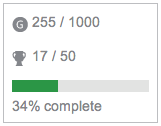Where games meet learning
In earlier posts, I’ve looked at the research evidence for and against the learning potential for games and how play in general relates to learning. This post looks at the overlap between games and learning. Although many people become quite aerated about definitions, for the sake of today’s note, I’m simply using ‘games’ to mean rule-based play.
In their 2005 report for Becta, Richard Sandford and Ben Williamson describe computer games as “ideal learning environments” where the important educational aspect of gaming is not what is being learnt but how – a recognition of a game’s tendency to promote higher order skills, that is independent critical thinking. Computer games display three significant characteristics to facilitate learning:
- Control;
- Practise;
- Presence.
The level of interactivity that is possible within a computer game gives a player unparalleled control over content. This control enables him to manipulate a ‘system’ and observe the consequences. In doing so, a player discovers the underlying rules and relationships that drive the environment and can formulate strategies to achieve the given aims.
The increasing complexity and difficulty within computer games requires dedication and practise to resolve. This repeated exposure to challenges encourages problem-solving skills and the refinement of thinking. Those improving skills reveal the game world rules and provide the basis for new application of those same skills to later and evolved problems and situations.
The themes and narrative of many computer games encourages players to identify with on-screen characters and situations. This identification stimulates a sense of presence and association with the events unfolding within the game. This presence often utilises specific environments, vocabulary and language which is particularly valuable the objective is real world training. Even in non-realistic environments, players will combine the role-playing aspects of controlling an avatar or character with their own attitudes and desires and therefore experience some degree of cognitive or affective change, that is to say, they’ll change their outlook on a particular issue.
There are two forms of learning associated with game play:
- Understanding the game environment, structures and interface
- Understanding the game content
The first point, at first sight, appears relatively superficial and simply enables the player to complete the current game task. However, players demonstrate a wide range of skills in accomplishing even the simplest activity within the game environment. These skills may be transferable and have application elsewhere. Although the tendency is to only think of motor skills (particularly when considering ‘twitch’ games) game play often requires the successful deployment of higher order skills such as synthesis and problem solving. Obviously, these skills are highly valuable in real-world contexts but require relevant translation. This translation is a skill in its own right.
The second form of learning is often perceived as more valuable, and the rationale for almost all educational games. In most cases, the game contexts for this learning are realistic ones, that is virtual facsimiles of aspects of life even abstract activities such as financial calculations . The game continuum describes the transparency of learning related with game world.
It is not just the characteristics of game play itself that makes games potentially useful for learning, they have a number of features that make them desirable learning environments:
- Opportunities for reflection and evaluation
- Access to feedback on performance
- Record progress
- Purposeful interactivity
- Achieving learning objectives
- Opportunities to collaborate, investigate or experience
- Chance to correct and learn from errors
These game ‘mechanics’ are highly transferable attributes that encourage greater effectiveness and engagement within resources of any kind and we’re increasingly seeing them deployed in all sorts of domains in the emerging process of ‘gamification’. I’ll expand on them in a later post but I’d be interested in your thoughts about gaming’s other learning characteristics.What else do they offer?

